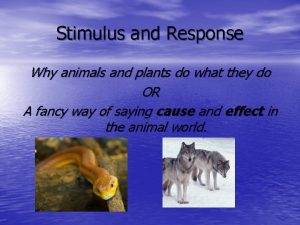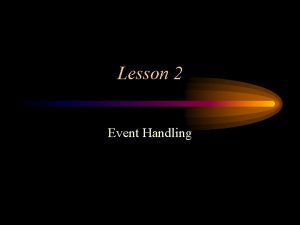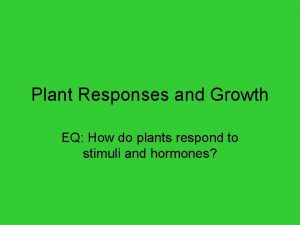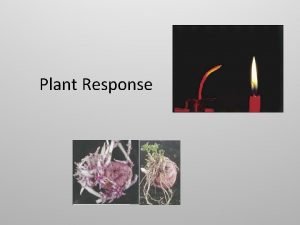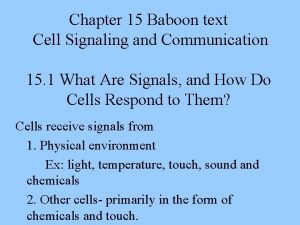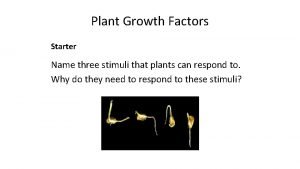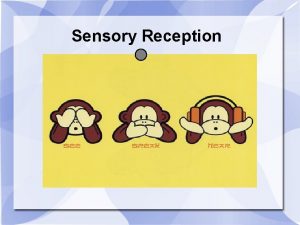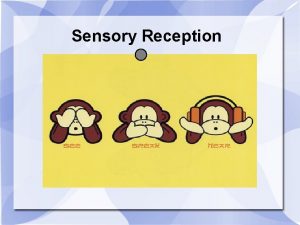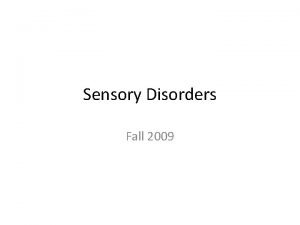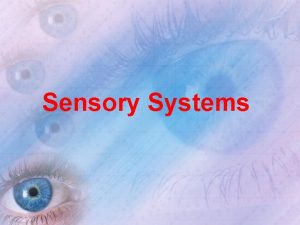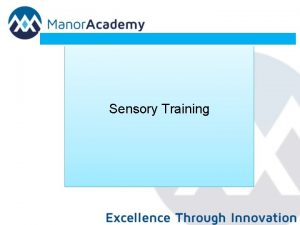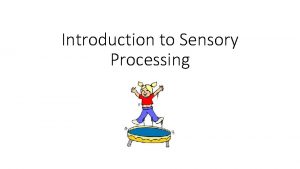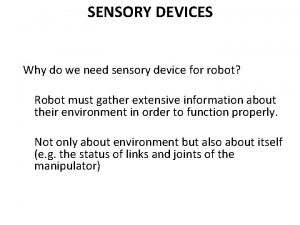Sensory reception LO understand why we respond to
































- Slides: 32

Sensory reception LO: understand why we respond to stimuli and the different responses

Match up definitions Stimulus Receptor Coordinator Effector Response A cell or organ that detects change in internal/ external environments A cell, tissue, organ or system that carries out a response A change brought about due to a stimulus A detectable change in the internal /external environment Connects information between the receptor and the appropriate effector

Match up definitions Stimulus A detectable change in the internal /external environment Receptor A cell or organ that detects change in internal/ external environments Coordinator Connects information between the receptor and the appropriate effector Effector A cell, tissue, organ or system that carries out a response Response A change brought about due to a stimulus

Stimulus and response �A stimulus is a detectable change in the internal or external environment of an organism that produces a response in that organism �The responses will generally be designed to enhance that animals chance of survival…… �What are some examples of a stimulus?

Simple forms of responses �Taxes �Kineses �Tropisms

Types of Responses The type of the stimulus is shown by prefixes: • • • Photo Geo Hydro Chemo Thigmo Thermo • • • Light Gravity Water Chemicals Touch Heat 6

Taxes and Kineses • Responses to stimuli in order to maintain favourable conditions

Taxes TAXES ARE DIRECTIONAL RESPONSES. • Taxes are movements by an animal towards or away from an environmental stimulus. • Movement towards a stimulus is a positive taxis, and movement away from a stimulus is a negative taxis.

Examples of taxes Single celled algae – As algae are photosynthetic they move towards light (positive phototaxis).

Examples of taxes Earthworms – Move away from light (negative phototaxis). Helps them survive as this takes them into the soil, helping them conserve water, find food and avoid predators.

Examples of taxes • Some Bacteria –Move towards areas where glucose (their food) is more concentrated (positive chemotaxis).

Examples of Taxes • A maggot placed on a sheet of paper will move randomly on the paper if the light source is uniform. • If a light is switched on coming from one direction only, the maggot will move away from the light. This is a negative phototaxis. • The advantage of this taxis to the maggot (and many other small invertebrates) is that moving away from light will take the maggot to a place of shelter where predators will not be able to get at them.

• The female silk moth releases a pheromone called bombykol. A male silk moth is able to detect single molecules of this substance and fly in the direction of the female in order to mate with her. He does this by having two antennae sensitive to the chemical on either side of his head. He will turn to whichever antennae detects the most bombykol. • This is an example of positive chemotaxis.

Positive Chemotaxis White blood cells move towards the chemicals released by inflamed and damaged tissues.

If the behaviour is movement in the direction of the stimulus or away from the stimulus then it is most likely a taxis. How do I recognise a taxis? 15

Taxes �Response direction is determined by the direction of the stimulus �Positive = towards stimulus �Negative = away from stimulus �Name determined by stimulus e. g �Towards light = Positive phototaxis �Away from chemicals = negative chemotaxis

Kinesis KINESES ARE NON-DIRECTIONAL RESPONSES. • A kinesis is a random movement response to an environmental stimulus that is not oriented toward or away from a stimulus. It is non-directional. • The rate of movement of an animal varies with the intensity of the stimulus.

Examples of kinesis Woodlice – lose water in dry conditions. • When in dry area – move more rapidly and change direction more often • When in damp area – move less rapidly and change direction less often. This increases the chance of the organism moving into or staying in favourable conditions, preventing them drying out and increasing their chance of survival.

19

Does the stimulus vary in intensity or concentration? Is the animal altering its rate of movement? If there is no obvious direction of the stimulus then the behaviour is likely to be a kinesis. How do I recognise a kinesis? 20

Kinesis �Animal responds to stimulus but it is not directional. �The more intense the stimulus the faster the movement and the more frequent the changes of direction seen in the animals movement. �This aids survival as it makes it more likely that the animal will reach favourable conditions where it will slow down and change direction less often. �Important when the stimulus does not have clear direction, e. g. woodlice moving until they reach damp areas so they do not dry out.

Kineses vs Taxes • Taxes - enables a faster, direct response to the stimulus but is only possible if the stimulus is directional. • Kineses – A slower response but allows a response to a stimulus that isn’t always directional, e. g. temperature or humidity.

Tropisms �The growth movement of part of a plant in response to a directional stimulus. Usually towards/away from stimulus, e. g. �Towards light – positive phototropism �Away from gravity – negative geotropism �Towards water – positive hydrotropism

Exam question

Answers (a) kinesis; random movements = 1 mark, e. g. degree of turning/number of turns depends on strength of stimulus/on temperature/allow specific ref. to more turning at 35° than at 30° / non-directional stimulus/response; ignore ‘speed’ 2 (b) stays longer in warmer area/at 35°C/tends to leave cooler area/to leave 30°C/stays in favourable conditions ; remains near food source/on host; � 2

Discuss the answers to these questions 1. What is a stimulus? Give four examples of stimuli. 2. What happens after a stimulus has been detected? Three key words are needed here. 3. Two types of response are TAXIS and KINESIS. What is the difference between these types of response? 4. How could you quantify a kinesis? 5. Describe one example of positive phototaxis in living organisms. 6. Give three examples of positive tropisms in plants

Responses experiments

Discuss the answers to these questions 1. What is a stimulus? Give four examples of stimuli. A change in the internal or external environment 2. What happens after a stimulus has been detected? Three key words are needed here. Receptor Coordinator Effector Response 3. Two types of response are TAXIS and KINESIS. What is the difference between these types of response? Taxes are directional. Kinesis are non directional (random movements. 4. How could you quantify a kinesis? By varying the stimulus (e. g. temperature) + counting the number of turns 5. Describe an example of positive phototaxis in living organisms. Algae move in the direction of light 6. Give three examples of positive tropisms in plants Roots – positive geotropism. Roots – positive hydrotropism. Shoots – positive phototropism

Nervous control: What happens when we sense something? Stimulus Receptor Sensory Nerone Effector Motor Neurone Coordinator Response

What type of reactions do we do automatically? �Reflex actions are designed to protect the organism. �They are faster than normal responses because they initially bypass the brain, this leaves the brain free to carry out more complex responses �A pain impulse will be sent to the brain but you will already have responded by then

Intermediate neurone

Now answer question 2 �On Monday you are going to design an experiment using choice chambers. If you finish this question you should start to plan this experiment
 To understand recursion you must understand recursion
To understand recursion you must understand recursion Hey hey bye bye
Hey hey bye bye Dont ask
Dont ask Stimulus in animals
Stimulus in animals Plan-protect-respond cycle
Plan-protect-respond cycle Inquiry business letter sample
Inquiry business letter sample Object respond to an event by writing
Object respond to an event by writing The buying process starts when the buyer recognizes a
The buying process starts when the buyer recognizes a External equalizer expansion valve
External equalizer expansion valve How to respond to teacher feedback
How to respond to teacher feedback How to respond to ni hao
How to respond to ni hao Ariba faurecia
Ariba faurecia Plan protect respond cycle
Plan protect respond cycle Producers respond to consumers' positive economic votes by
Producers respond to consumers' positive economic votes by Brain warmer
Brain warmer Respond picture
Respond picture What reason does antonio give for being sad
What reason does antonio give for being sad How to respond to instructions
How to respond to instructions The plan-protect-respond cycle
The plan-protect-respond cycle Show me your ways meaning
Show me your ways meaning Decision letter sample
Decision letter sample Respond to
Respond to Respond to
Respond to The plan-protect-respond cycle
The plan-protect-respond cycle Respond to
Respond to 3 types of cell signaling
3 types of cell signaling Respond census gov nscg
Respond census gov nscg Prepare mitigate respond recover
Prepare mitigate respond recover What are three stimuli that plants respond to
What are three stimuli that plants respond to Metamorphosis activity
Metamorphosis activity Lara listen affirm respond add
Lara listen affirm respond add How does thoreau respond to being jailed
How does thoreau respond to being jailed If a resident with ad shows violent behavior the na should
If a resident with ad shows violent behavior the na should



